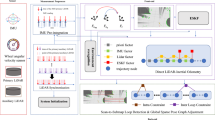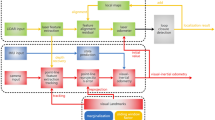Abstract
Simultaneous localization and mapping (SLAM) is a fundamental requirement for mobile robots like self-driving cars. Vision-based methods have advantages in sensor cost and loop closure detection, but are sensitive to illumination change and texture deficiency. Lidar-based SLAM systems perform better in accuracy, field-of-view and robustness to environmental changes, but may easily fail in structure-less scenarios. To compensate for the deficiencies of standalone sensors and provide more efficient SLAM functions, in this paper we propose a tightly coupled monocular visual lidar odometry, which tightly fuses the measurements of a monocular camera and a 3D lidar in a joint optimization. The system starts with a data preprocessing module, which outputs 3D visual and laser features through feature extraction and data association. Furthermore, the tightly coupled visual lidar odometry tightly fuses the visual and laser features in a unified optimization framework to estimate the transformation between consecutive scans. Finally, we combine visual and vicinity loop detection to construct loop constraints and optimize a 6-DOF global pose graph to achieve global-consistent pose estimation and environment mapping. The performance of our system is verified in the public KITTI dataset, and the experimental results demonstrate that the proposed method can run in real time with the 64-line lidar data and achieve better in accuracy, runtime and mapping against other state-of-the-art lidar-based and fusion-based methods.














Similar content being viewed by others
Explore related subjects
Discover the latest articles and news from researchers in related subjects, suggested using machine learning.References
Besl PJ, McKay ND (1992) Method for registration of 3-d shapes. In: Sensor fusion IV: control paradigms and data structures, vol 1611. International Society for Optics and Photonics, pp 586–606
Bogoslavskyi I, Stachniss C (2016) Fast range image-based segmentation of sparse 3d laser scans for online operation. In: 2016 IEEE/RSJ international conference on intelligent robots and systems (IROS). IEEE, pp 163–169
Calonder M, Lepetit V, Strecha C, Fua P (2010) Brief: binary robust independent elementary features. In: European conference on computer vision. Springer, pp 778–792
Cheng J, Wang C, Meng MQH (2019) Robust visual localization in dynamic environments based on sparse motion removal. IEEE Trans Autom Sci Eng 1–12
Curless B, Levoy M (1996) A volumetric method for building complex models from range images. In: Proceedings of the 23rd annual conference on Computer graphics and interactive techniques, pp 303–312
De Croce M, Pire T, Bergero F (2019) Ds-ptam: distributed stereo parallel tracking and mapping slam system. J Intell Robotic Syst 95(2):365–377
Deschaud JE (2018) Imls-slam: scan-to-model matching based on 3d data. In: 2018 IEEE international conference on robotics and automation (ICRA). IEEE, pp 2480–2485
Engel J, Stückler J, Cremers D (2015) Large-scale direct slam with stereo cameras. In: 2015 IEEE/RSJ international conference on intelligent robots and systems (IROS). IEEE, pp 1935–1942
Gálvez-López D, Tardos JD (2012) Bags of binary words for fast place recognition in image sequences. IEEE Trans Robotics 28(5):1188–1197
Gao X, Wang R, Demmel N, Cremers D (2018) Ldso: direct sparse odometry with loop closure, pp 2198–2204
Geiger A, Lenz P, Urtasun R (2012) Are we ready for autonomous driving? the kitti vision benchmark suite. In: 2012 IEEE conference on computer vision and pattern recognition. IEEE, pp 3354–3361
Himmelsbach M, Hundelshausen FV, Wuensche HJ (2010) Fast segmentation of 3d point clouds for ground vehicles. In: 2010 IEEE intelligent vehicles symposium. IEEE, pp 560–565
Kaess M, Johannsson H, Roberts R, Ila V, Leonard J, Dellaert F (2011) isam2: incremental smoothing and mapping with fluid relinearization and incremental variable reordering. In: 2011 IEEE international conference on robotics and automation. IEEE, pp 3281–3288
Kim D, Shin S, Kweon IS (2018) On-line initialization and extrinsic calibration of an inertial navigation system with a relative preintegration method on manifold. IEEE Trans Autom Sci Eng 15(3):1272–1285
Li G, Yu L, Fei S (2020) A binocular msckf-based visual inertial odometry system using lk optical flow. J Intell Robotic Syst 100(3):1179–1194
Lucas BD, Kanade T et al (1981) An iterative image registration technique with an application to stereo vision
Lynen S, Achtelik MW, Weiss S, Chli M, Siegwart R (2013) A robust and modular multi-sensor fusion approach applied to mav navigation. In: 2013 IEEE/RSJ international conference on intelligent robots and systems. IEEE, pp 3923–3929
Mccormac J, Handa A, Davison AJ, Leutenegger S (2017) Semanticfusion: dense 3d semantic mapping with convolutional neural networks, pp 4628–4635
Mourikis AI, Roumeliotis SI (2007) A multi-state constraint kalman filter for vision-aided inertial navigation. In: Proceedings 2007 IEEE international conference on robotics and automation. IEEE, pp 3565–3572
Mur-Artal R, Tardós JD (2017) Orb-slam2: an open-source slam system for monocular, stereo, and rgb-d cameras. IEEE Trans Robotics 33(5):1255–1262
Qin T, Li P, Shen S (2018) Vins-mono: a robust and versatile monocular visual-inertial state estimator. IEEE Trans Robotics 34(4):1004–1020
Ramasubramanian V, Paliwal KK (1992) Fast k-dimensional tree algorithms for nearest neighbor search with application to vector quantization encoding. IEEE Trans Sig Process 40(3):518–531
Shan T, Englot B (2018) Lego-loam: lightweight and ground-optimized lidar odometry and mapping on variable terrain. In: 2018 IEEE/RSJ international conference on intelligent robots and systems (IROS). IEEE, pp 4758–4765
Shao W, Vijayarangan S, Li C, Kantor G (2019) Stereo visual inertial lidar simultaneous localization and mapping. arXiv preprint arXiv:1902.10741
Shi J et al (1994) Good features to track. In: 1994 Proceedings of IEEE conference on computer vision and pattern recognition. IEEE, pp 593–600
Wang Z, Zhang J, Chen S, Yuan C, Zhang J, Zhang J (2019) Robust high accuracy visual-inertial-laser slam system. In: 2019 IEEE/RSJ international conference on intelligent robots and systems (IROS). IEEE, pp 6636–6641
Yang Z, Shen S (2017) Monocular visual-inertial state estimation with online initialization and camera-imu extrinsic calibration. IEEE Trans Autom Sci Eng 14(1):39–51
Zhang J, Kaess M, Singh S (2016) On degeneracy of optimization-based state estimation problems. In: 2016 IEEE international conference on robotics and automation (ICRA). IEEE, pp 809–816
Zhang J, Singh S (2015) Visual-lidar odometry and mapping: low-drift, robust, and fast. In: 2015 IEEE international conference on robotics and automation (ICRA). IEEE, pp 2174–2181
Zhang J, Singh S (2017) Low-drift and real-time lidar odometry and mapping. Autonom Robots 41(2):401–416
Zhang J, Singh S (2018) Laser-visual-inertial odometry and mapping with high robustness and low drift. J Field Robotics 35(8):1242–1264
Zuiderveld KJ (1994) Contrast limited adaptive histogram equalization. Graphics gems, pp 474–485
Funding
This work was supported in part by the National Natural Science Foundation of China (61973099).
Author information
Authors and Affiliations
Contributions
All authors contributed to the study conception and design. All authors commented on previous versions of the manuscript, and approved the final manuscript.
Corresponding author
Ethics declarations
Conflicts of interest
The authors declare that there is no conflict of interests regarding the publication of this paper.
Ethics approval
The authors declare that there are no ethics issues regarding the publication of this paper.
Additional information
Publisher's Note
Springer Nature remains neutral with regard to jurisdictional claims in published maps and institutional affiliations.
Rights and permissions
About this article
Cite this article
Meng, L., Ye, C. & Lin, W. A tightly coupled monocular visual lidar odometry with loop closure. Intel Serv Robotics 15, 129–141 (2022). https://doi.org/10.1007/s11370-021-00406-2
Received:
Accepted:
Published:
Issue Date:
DOI: https://doi.org/10.1007/s11370-021-00406-2




